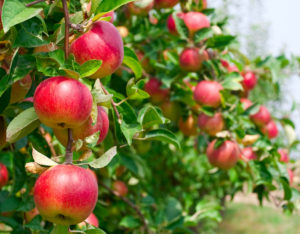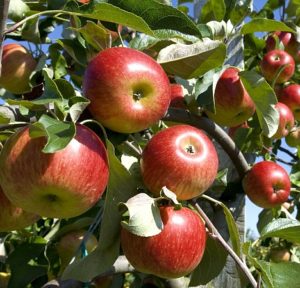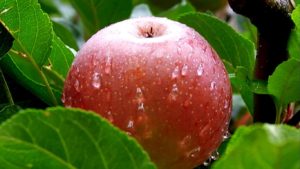Introduction of Apple: - Apple fruit is the oldest and commercially the most important temperate fruit and is fourth among the most widely produced fruits in the world. In India it is mostly grown in Kashmir, hills of Uttar Pradesh, Himachal Pradesh. Apple cultivation also extended to Nagaland, Sikkim, Arunachal Pradesh, and Meghalaya. Apple is mostly consumed as fresh but a small part of the production is processed in to jellies, juices, canned slices, candies.
- Apple fruit is the oldest and commercially the most important temperate fruit and is fourth among the most widely produced fruits in the world. In India it is mostly grown in Kashmir, hills of Uttar Pradesh, Himachal Pradesh. Apple cultivation also extended to Nagaland, Sikkim, Arunachal Pradesh, and Meghalaya. Apple is mostly consumed as fresh but a small part of the production is processed in to jellies, juices, canned slices, candies.
Health Benefits of Apple: - Top 4 health benefits of taking apple daily.
1. Apples aid in brain health.
2. Apples reduce the risk of stroke or heart disease.
3. Eating apples may reduce risk for Type-2 Diabetes.
4. Apples have a number of properties that can help reduce the risk of cancer.
Commercial Varieties of Apple: - Below Listed are some of the commercially cultivated varieties of Apples in India.
Category Varieties
Clonal rootstocks - M7,M9, M 26, MM 11, MM 106
Scab resistant - Florina, Macfree, Nova Easy Grow, Prima, Priscilla, Sir Prize, Jonafree, Coop 12, Coop
13 (Redfree), Firdous, Nova Mac, Liberty, Freedom, Shireen.
Hybrids - Lal Ambir (Red Delicious x Ambri), Ambred (Red Delicious x Ambri), Sunehari (Ambri x
Golden Delicious), Chaubattia Princess, Chaubattia Anupam (Early Shanburry x Red
Delicious), Ambrich (Richared X Ambri), Ambroyal (Starking Delicious x Ambri).
Low Chilling - Anna, Tropical Beauty, Michal, Tamma, Vered, Neomi, Schlomit, Parlin’s Beauty.
Pollinizing - Winter Banana, Granny Smith, Tydeman;s Early, Red Gold, Goden Delicious, Mc
Intosh, Starkspur Golden, Lord Lambourane, Golden Spur.
Climate required for Apple Farming: - Apple can be grown at altitudes 1,500 m to 2,700 m, above sea level, in the Himalayan range which experience 1,000 tp 1,500 hours of chilling or cooling (the number of hours during which temperatures remains at or below 70C in winter season). The temperature during the apple growing season should be around 21C to 24C. For best growth and fruiting, Apple trees need 100cm to 125cm of annual rainfall, evenly spread throughout the year. Too much of rainfall and fog near the fruit maturity period would result in poor fruit quality with improper colour development of fruit and fungal spots on fruit surface. Apple cultivation is not suitable where high velocity of winds is expected.
Soil requirement for apple farming: - Apple cultivation is suitable in loamy soils with rich inorganic matter and Ph range of 5.5 – 6.5. Soil should not have water logging and soil with good drainage is ideal for apple farming should be purchased only from the registered nurseries and care should be taken care while transporting those.

What is the best time for Apple Plantation: - Apple is normally done January and February months.
Planting and Spacing in Apple Farming: - The average number of plants in area of one hac, may range from 200 to 1250. 4 different categories of planting density are implemented viz. Low (Less than 300 apple plants per hectare) and ultra high density (more than 1300 plants per hectare). The combination of scion and rootstock variety determines the apple plant spacing and planting density unit area.
Planting Method in Apple farming: - Hexagonal (or) square system of plantation is followed in the valleys whereas contour method is normally followed on the slopes. Apple plantation of pollinator species in between the main species is required for proper apple fruit setting. For establishment of Royal Delicious variety, plantation of Golden Delicious and Red Delicious as pollinators is recommended by the Horticulture Department. Dig pits of size 1m x 1m x 1m kg of farm Yard Manure (FYM), 500 grams of Single super phosphate and 50 grams of Malathion dust are added after mixing properly, follow one irrigation immediately after plantation.
Manures and Fertilization in Apple farming: - Farm Yard Manure (FMY) at 10kg per year age of tree is applied along with other fertilizers. The ration of K.P and N which is applied in an orchard of optimal fertility is 70:35:70 grams per year (age of the tree). After 10 years of tree age, the dose should be stabilized at 700:3500:700 grams of K, P and N per year. The standard fertilizer dose of K, P and in an “off” year (when the crop load is low) is 400 grams, 250 grams and 500 grams respectively. For deficiency of boron, zinc, manganese and calcium use appropriate application of fertilizer.
Inter cultural Operations and Weed Control in Apple farming: - Applying glyphosate @ 800 ml/hacker or Gammaxone /Paraquat (0.5%) as post emergence herbicide will destroy the weed growth for 4 to 5 months.
Irrigation/water supply in apple farming: - The irrigation requirement in Apple farming is 115cm/annum which should be scheduled in 14 to 20 watering/irrigations. In summer, watering should be provided at an interval of 6 to 10 days while in winter is given at an interval of 3 to 4 weeks. At least 8 irrigations are required during critical period April to after fruit set.
Training and pruning in Apple farming: - Timely training and pruning activity is required for proper growth and good quality of apples. The apple plants are trained as per growth habit and vigour of the rootstocks. The standard apple trees are trained on modified central leader system to receive peoper light. This improves apple fruit color and also minimizes the effect of heavy snowfall and hail. Spindle bush system is best suitable for high density apple planting under mid hill conditions.
Inter cultivation in Apple farming: - Green manuring crops like bean and sunflower can be cultivated in the early years of apple planting in order to increase soil texture and nutrients of soil.
Mulching in Apple farming:- Using of Oak leaves or dry grass found to be effective in conserving soil moisture.
Pests and Diseases in Apple farming: - The main pests in apple plantation are wooly apple aphid (Eriosoma lanigerum), san lose scale (Quadraspidiotus perniciosus), blossom thrips (Thrips rhoplanaternalis), white scale (Pseudoulacaspis sp.) etc. Suitable intercultural operations planting of resistant rootstocks, and spraying with fenitrothion, chloropyriphos, carbaryl etc. have been found to be more effective in controlling the pests in apple Plantation.
The main diseases found in apple farming are apples scab (Venturial inaequalis), collar rot (Phytophthora cactorum), crown gall (Agrobacterium tumefaciens), sclerotius blight (Sclerotium rolfsii), cankers, die-back diseases etc. Apple plants that are resistant to the diseases should be used for cultivation. The infected plant parts should be destroyed. Apply carbendazim, copper oxychloride, mancozeb and other fungicides for controlling the diseases.
Disorders in Apple farming: - In apple planting, there are three distinct fruit drops,
1. Early drop resulting from unfertilized blossoms or unpollinated.
2. Due to moisture stress and fruit competition in June there will be a drop.
3. Pre-harvest drop. This drop can be controlled by spraying NAA at 10 ppm. (1 ml. of planofix dissolved in 4.5 liters of water) about a week before the expected fruit drop.
 Harvesting of Apples: - The apple tree start bearing from 8th year and the from 8th to 17th year, apple productivity goes on increasing and afterwards production remains constant up to 30 years. The level of apple productivity varies from elevation to elevation. Apple tree life can be extended up to even 40 years depending upon climatic condition. The Apple fruits are normally harvested before they are fully ripe.
Harvesting of Apples: - The apple tree start bearing from 8th year and the from 8th to 17th year, apple productivity goes on increasing and afterwards production remains constant up to 30 years. The level of apple productivity varies from elevation to elevation. Apple tree life can be extended up to even 40 years depending upon climatic condition. The Apple fruits are normally harvested before they are fully ripe.
Yield of Apples: - The average yield of different apple varieties in Jammu & Kashmir and Himachal Pradesh which is around 11 to 13 tonnes / hectare. In Uttaranchal state, yield is reported as very low 5 to 6 tonnes /hectare.
Post Harvest Management activities in Apple farming: -
Pre- cooling of Apples:- The Apple fruits are placed in a ventilated cool place to remove field heat before packing them. Apple Surface must be free from moisture before grading, wrapping, and packing in cartons.
Grading of Apples:- Grading of apples depends on fruit size and fruit appearance or quality. These grades are designated as A,B,C, AA, AAA or fancy class 1 and fancy Class 2, Extra fancy.
Storage of Apples: - Apple fruits have a long storage life compared to other fruits and can be store for a period of 4 to 8 months, after harvesting fruits can be kept in cold storage at a temperature of about 1.10 to 00 C and with 85-90% relative humidity.
Packing of Apples: - Apples are normally packed in wooden boxes having the capacity to accommodate about 10 kg or 20 kg fruits.
Transport and Marketing of Apples: - Apples can be transported via trucks to the local market or apples can also be marketed to local commission agents.
